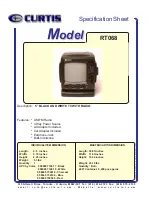
PXIe-5673E Calibration Procedure
|
© National Instruments
|
11
8.
Calculate the image suppression ratio (ISR) and carrier suppression ratio (CSR) according
to the following formulas and save the values:
ISR
=
Measured Image Power
-
Measured RF Output Power
CSR
=
Measured Carrier Leakage Power
-
Measured RF Output Power
9.
Repeat steps 4 though 8 for the following LO frequency ranges in 10 MHz steps, including
endpoints:
•
PXIe-5650: 85 MHz to 1.3 GHz
•
PXIe-5651: 85 MHz to 3.3 GHz
•
PXIe-5652: 85 MHz to 6.6 GHz
Store the resulting measurements.
Note
With the baseband set to 1 MHz and a 0 dBm single-sideband tone, the RF
output is always 1 MHz above the LO frequency, the image is 1 MHz below the LO
frequency, and the carrier leakage is at LO frequency.
10. Use Table 4 to compare the
ISR
and
CSR
from step 8 for each LO frequency.
If the results are within the selected test limit, the device has passed this portion of the
verification.
Verifying Modulation Bandwidth and Impairments
Complete the following steps to verify the modulation bandwidth performance and modulation
impairments of the PXIe-5673E using a spectrum analyzer.
1.
Connect the PXIe-5611 RF OUT front panel connector to the spectrum analyzer RF INPUT
front panel connector through the SMA(m)-to-SMA(m) cable.
2.
Connect the PXIe-5650/5651/5652 REF IN/OUT front panel connector to any rubidium
frequency reference rear panel BNC connector through the BNC(m)-to-SMA(m) cable.
Table 4.
Modulation Impairments Verification Upper Test Limits
CW Source
LO Frequency (MHz)
ISR (dBc)
Test Limit
CSR (dBc)
Test Limit
PXIe-5650/5651/5652
85 MHz to 400 MHz
-43
-44
>400 MHz to 1.3 GHz
-50
-44
PXIe-5651/5652
1.3 GHz to 2.5 GHz
-50
-44
>2.5 GHz to 3.3 GHz
-46
-44
PXIe-5652
>3.3 GHz to 5.5 GHz
-46
-44
>5.5 GHz to 6.6 GHz
-43
-41












































